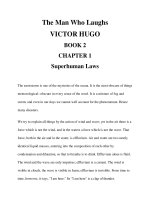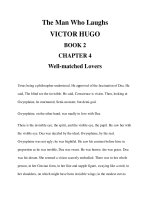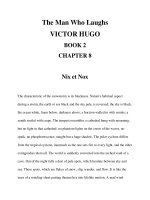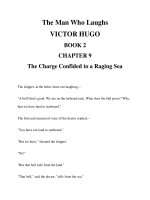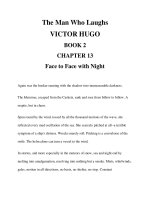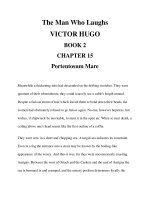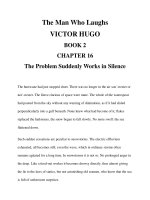The Man Who Laughs VICTOR HUGO PART 1- BOOK 2 CHAPTER 1 Superhuman Laws The snowstorm is one of the ppsx
Bạn đang xem bản rút gọn của tài liệu. Xem và tải ngay bản đầy đủ của tài liệu tại đây (16.55 KB, 5 trang )
The Man Who Laughs
VICTOR HUGO
BOOK 2
CHAPTER 1
Superhuman Laws
The snowstorm is one of the mysteries of the ocean. It is the most obscure of things
meteorological obscure in every sense of the word. It is a mixture of fog and
storm; and even in our days we cannot well account for the phenomenon. Hence
many disasters.
We try to explain all things by the action of wind and wave; yet in the air there is a
force which is not the wind, and in the waters a force which is not the wave. That
force, both in the air and in the water, is effluvium. Air and water are two nearly
identical liquid masses, entering into the composition of each other by
condensation and dilatation, so that to breathe is to drink. Effluvium alone is fluid.
The wind and the wave are only impulses; effluvium is a current. The wind is
visible in clouds, the wave is visible in foam; effluvium is invisible. From time to
time, however, it says, "I am here." Its "I am here" is a clap of thunder.
The snowstorm offers a problem analogous to the dry fog. If the solution of the
callina of the Spaniards and the quobar of the Ethiopians be possible, assuredly
that solution will be achieved by attentive observation of magnetic effluvium.
Without effluvium a crowd of circumstances would remain enigmatic. Strictly
speaking, the changes in the velocity of the wind, varying from 3 feet per second to
220 feet, would supply a reason for the variations of the waves rising from 3 inches
in a calm sea to 36 feet in a raging one. Strictly speaking, the horizontal direction
of the winds, even in a squall, enables us to understand how it is that a wave 30
feet high can be 1,500 feet long. But why are the waves of the Pacific four times
higher near America than near Asia; that is to say, higher in the East than in the
West? Why is the contrary true of the Atlantic? Why, under the Equator, are they
highest in the middle of the sea? Wherefore these deviations in the swell of the
ocean? This is what magnetic effluvium, combined with terrestrial rotation and
sidereal attraction, can alone explain.
Is not this mysterious complication needed to explain an oscillation of the wind
veering, for instance, by the west from south-east to north-east, then suddenly
returning in the same great curve from north-east to south-east, so as to make in
thirty-six hours a prodigious circuit of 560 degrees? Such was the preface to the
snowstorm of March 17, 1867.
The storm-waves of Australia reach a height of 80 feet; this fact is connected with
the vicinity of the Pole. Storms in those latitudes result less from disorder of the
winds than from submarine electrical discharges. In the year 1866 the transatlantic
cable was disturbed at regular intervals in its working for two hours in the twenty-
four from noon to two o'clock by a sort of intermittent fever. Certain
compositions and decompositions of forces produce phenomena, and impose
themselves on the calculations of the seaman under pain of shipwreck. The day
that navigation, now a routine, shall become a mathematic; the day we shall, for
instance, seek to know why it is that in our regions hot winds come sometimes
from the north, and cold winds from the south; the day we shall understand that
diminutions of temperature are proportionate to oceanic depths; the day we realize
that the globe is a vast loadstone polarized in immensity, with two axes an axis of
rotation and an axis of effluvium intersecting each other at the centre of the earth,
and that the magnetic poles turn round the geographical poles; when those who risk
life will choose to risk it scientifically; when men shall navigate assured from
studied uncertainty; when the captain shall be a meteorologist; when the pilot shall
be a chemist; then will many catastrophes be avoided. The sea is magnetic as much
as aquatic: an ocean of unknown forces floats in the ocean of the waves, or, one
might say, on the surface. Only to behold in the sea a mass of water is not to see it
at all: the sea is an ebb and flow of fluid, as much as a flux and reflux of liquid. It
is, perhaps, complicated by attractions even more than by hurricanes; molecular
adhesion, manifested among other phenomena by capillary attraction, although
microscopic, takes in ocean its place in the grandeur of immensity; and the wave of
effluvium sometimes aids, sometimes counteracts, the wave of the air and the wave
of the waters. He who is ignorant of electric law is ignorant of hydraulic law; for
the one intermixes with the other. It is true there is no study more difficult nor
more obscure; it verges on empiricism, just as astronomy verges on astrology; and
yet without this study there is no navigation. Having said this much we will pass
on.
One of the most dangerous components of the sea is the snowstorm. The
snowstorm is above all things magnetic. The pole produces it as it produces the
aurora borealis. It is in the fog of the one as in the light of the other; and in the
flake of snow as in the streak of flame effluvium is visible.
Storms are the nervous attacks and delirious frenzies of the sea. The sea has its
ailments. Tempests may be compared to maladies. Some are mortal, others not;
some may be escaped, others not. The snowstorm is supposed to be generally
mortal. Jarabija, one of the pilots of Magellan, termed it "a cloud issuing from the
devil's sore side."[2]
The old Spanish navigators called this kind of squall la nevada, when it came with
snow; la helada, when it came with hail. According to them, bats fell from the sky,
with the snow.
Snowstorms are characteristic of polar latitudes; nevertheless, at times they glide
one might almost say tumble into our climates; so much ruin is mingled with the
chances of the air.
The Matutina, as we have seen, plunged resolutely into the great hazard of the
night, a hazard increased by the impending storm. She had encountered its menace
with a sort of tragic audacity; nevertheless, it must be remembered that she had
received due warning.
